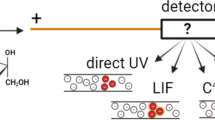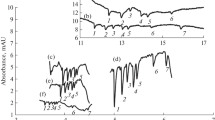Summary
An analytical method is presented for the detection and quantitative determination of sugars and uronic acids derived from natural thickeners and gums used in food production. The method is suitable for the analysis of agar, carrageenan, sodium alginate, locust bean gum, guar gum, gum arabic, pectin, gum tragacanth, xanthan, carboxymethylcellulose, propyleneglycolalginate, gum ghatti, tamarind, and gum karaya.
The polysaccharides are cleaved by methanolysis followed by trimethylsilylation of the methylglycosides formed. The separation and quantitation is performed by gas chromatography using glass capillary columns.
More than 200 samples of commercial thickeners and gums were analyzed by the method described. In most cases the natural sugar composition of the hydrocolloids did not vary more than 10–15%.
Zusammenfassung
Eine Analysenmethode wird beschrieben, mit der alle Zuckerbausteine der für Lebensmittel verwendeten, natürlichen Dickungsmittel in kurzer Zeit qualitativ und quantitativ bestimmt werden können. Erfaßt werden dabei Agar Agar, Carrageen, Natriumalginat, Johannisbrotkernmehl, Guar, Gummi arabicum, Pectin, Tragant, Xanthan, Carboxymethylcellulose, Propylenglykolalginat, Ghattigummi, Tamarindenkernmehl und Karayagummi.
Man spaltet die Polysaccharide mit methanolischer Salzsäure in ihre Bausteine und überführt die entstehenden 1-Methylglykoside der Neutralzucker bzw. die 1-Methylglykosid-6-methylester der Uronsäuren in die Trimethylsilylderivate. Die Auftrennung erfolgt durch Gaschromatographie an einer Glascapillarsäule.
Mit dieser Methode wurden über 200 Muster von Hydrokolloiden aus dem Handel untersucht. Die natürlichen Schwankungen in der Zusammensetzung der Dickungsmittel betrugen in den meisten Fällen höchstens 10–15%.
Similar content being viewed by others
Literatur
Zusatzstoff-Zulassungs VO (1977) BGBl 1: 2711
Grau R, Schweiger A (1963) Z Lebensm Unters Forsch 119:210
Southgate DAT (1969) J Sci Food Agr 20:331
Neukom H, Pilnik W (1980) Gelier- und Verdickungsmittel in Lebensmitteln. Forster, Zürich
Whistler RL (1973) Industrial Gums. Academic Press, New York London
Fachgruppe Lebensmittelchemie und gerichtliche Chemie, Gesellschaft deutscher deutscher Chemiker (1976) Monographien zur Technologie der Zusatzstoffe Teil III: Hydrokolloide als Stabilisatoren, Dickungs- und Geliermittel in Lebensmitteln. Frankfurt
Scherz H, Mergenthaler E (1980) Z Lebensm Unters Forsch 170:280
Glück U, Thier HP (1980) Z Lebensm Unters Forsch 170:272
Chambers RE, Clamp JR (1971) Biochem J 125:1009
Varma R, Varma RS, Allen WS, Wardi AH (1973) J Chromatogr 86:205
Bouche J, Verzele M (1968) J Gas Chromatogr 6:501
Pritehard DG, Todd CW (1977) J Chromatogr 133:133
Szejtli J (1976) Säurehydrolyse glykosidischer Bindungen. VEB-Fachbuchverlag, Leipzig
Akhrem AA, Avvakumov GV, Sviridov OV, Strel'chyonok OA (1978) J Chromatogr 166:123
Sweeley CC, Bentley R, Makita M, Wells WW (1963) J Am Chem Soc 85:2497
Zürcher K, Hadorn H (1974) Deut Lebensm Rundschau 70:425
Author information
Authors and Affiliations
Rights and permissions
About this article
Cite this article
Preuß, A., Thier, HP. Quantitative Analyse natürlicher Dickungsmittel durch Methanolyse und Capillargaschromatographie. Z Lebensm Unters Forch 175, 93–100 (1982). https://doi.org/10.1007/BF01135043
Received:
Issue Date:
DOI: https://doi.org/10.1007/BF01135043




